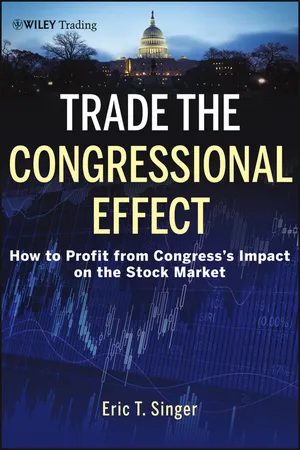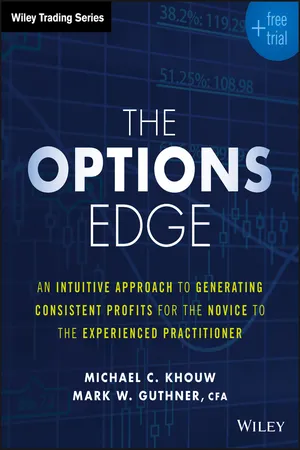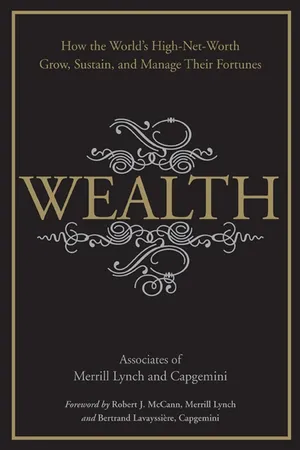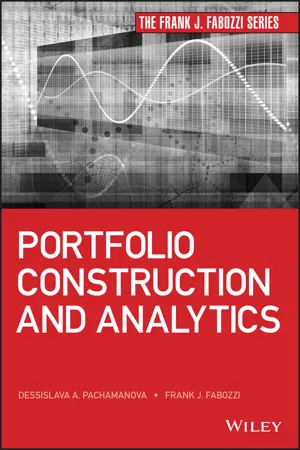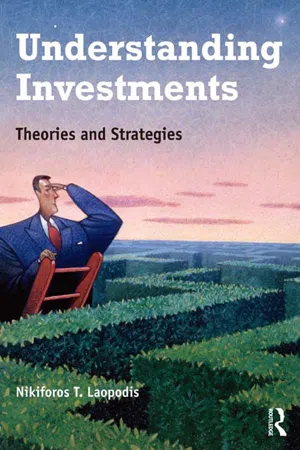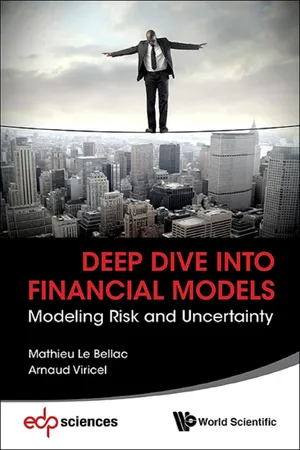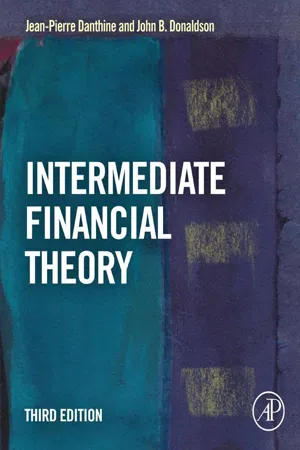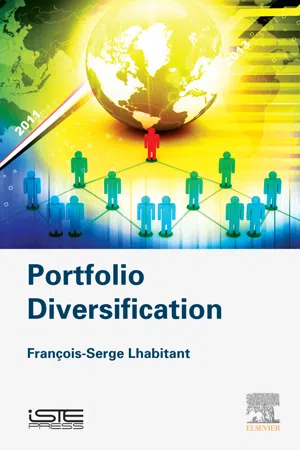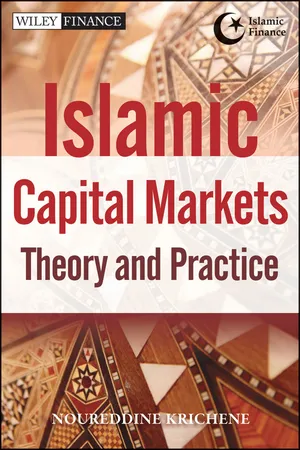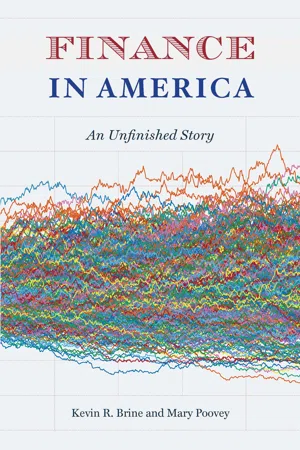Business
Modern Portfolio Theory
Modern Portfolio Theory is an investment strategy that aims to maximize returns for a given level of risk by diversifying the portfolio. It emphasizes the importance of asset allocation and the benefits of combining assets with different risk and return characteristics. The theory was developed by Harry Markowitz and has had a significant impact on the field of finance.
Written by Perlego with AI-assistance
Related key terms
Related key terms
1 of 4
Related key terms
1 of 3
12 Key excerpts on "Modern Portfolio Theory"
- eBook - ePub
Trade the Congressional Effect
How To Profit from Congress's Impact on the Stock Market
- Eric T. Singer(Author)
- 2012(Publication Date)
- Wiley(Publisher)
Chapter 2 The Congressional Effect and the Limits of Modern Portfolio TheoryModern Portfolio Theory (MPT) is a theory of investment that attempts to maximize expected return for a given amount of risk, or equivalently minimize risk for a given level of expected return, by carefully choosing the proportions of various assets within a portfolio. It was first articulated by Harry Markowitz in a groundbreaking article in 1952 entitled “Portfolio Selection.”1To briefly summarize his findings, he focused on two kinds of risk, the first of which was “systematic” or “market,” which related to the broad economy and included such factors as the overall economy, wars, crop failures, floods, the broad equity market, interest rates, and other macro factors that could not easily be reduced by diversification. The other risk in a portfolio was “unsystematic” or “specific” risk, which related to how an individual stock might perform in ways uncorrelated with the overall portfolio. He showed that by prudently diversifying a portfolio, the risks of individual stocks could be used to reduce the overall volatility of a portfolio and give it greater predictability.This chapter is a brief overview of Modern Portfolio Theory, which assumes that the market has fully digested all relevant information available at the time of investment. One corollary of this theory is that since the market has full access to data and is efficient, the short-term distribution of stock prices is likely to be so random that it does not make investment sense to ever try to time the market. The assumptions behind MPT are examined. This chapter then looks at the distribution of daily prices in connection with the Congressional Effect and finds that they are historically not random, and concludes that it can make investment sense to trade the Congressional Effect. - eBook - ePub
The Options Edge
An Intuitive Approach to Generating Consistent Profits for the Novice to the Experienced Practitioner
- Michael C. Khouw, Mark W. Guthner(Authors)
- 2016(Publication Date)
- Wiley(Publisher)
Herein lies the paradox. If options are priced in arbitrage-free environment, then both buyers and sellers of options should earn a fair risk-adjusted rate of return over time. To answer the question, “Are options fairly priced?” we need to delve more deeply into why sellers of options seem to get the upper hand over option buyers. To begin to answer that question, we need to start with an analysis of option pricing in the context of a generalized asset-pricing model. The primary hypothesis we make in choosing an asset-pricing model is the assumption of rational pricing. If option prices are fair, then there is a rational reason for the prices and returns we observe historically. We should expect to see that price and return behavior in the future should reflect what we see in the historical data. If we were to simply argue that option prices are irrational, then there would be no concrete reason for the returns we observe in the options market. This would suggest that market participants price options in a haphazard manner, which we believe is simply not the case. We believe that the market, in fact, prices assets fairly as postulated by the efficient market hypothesis. An outgrowth of that hypothesis is the capital asset pricing model (CAPM), which prices assets as a function of both the return on a risk-free asset and the market risk imbedded in the security itself. To analyze the return behavior of options, we will use CAPM as a mathematical construct to examine the historical return behavior of both put and call options. This model for pricing assets falls out of Modern Portfolio Theory, which is based on the premise that investors will construct portfolios in a way that maximizes return and minimizes risk. These concepts are described in greater detail below.Modern Portfolio Theory (MPT)
Modern Portfolio Theory (MPT) is a concept of investment finance that is concerned with how a rational investor constructs a portfolio. It rests on the proposition that investors want to maximize their financial well-being (i.e., desire high returns) but are risk averse (i.e., want to avoid or at least minimize losses) at the same time. In practice, MPT has evolved into a mathematical model that attempts to maximize a portfolio's expected rate of return given a particular level of risk. This is equivalent to minimizing risk for a given level of expected return. Within this framework, risk is defined and quantified as the standard deviation of returns. The objective of maximizing risk-adjusted rates of return is achieved through diversification. This is a process of selecting a group of investments that, as a package, produces a higher rate of return at a lower level of risk than any of the individual assets held in the portfolio. The benefits of diversification are achieved when the combination of assets held are not perfectly positively correlated. Under these circumstances, the value of the assets held in the portfolio do not necessarily rise or fall at the same time. When the value of some assets increases, the value of others assets might climb, fall, or stay the same. The best diversifying asset is one that is negatively correlated to the price action of other assets in the portfolio. A negatively correlated asset will increase in price when others fall, and vice versa. With such an asset, the portfolio will enjoy low volatility of returns. Through diversification, we should earn the expected rate of return on the individual assets in the long run, but endure a lower level of return volatility throughout the investment holding period. The following are the equations used to quantify return and risk. Put together, they allow the investor to construct an optimal portfolio. - eBook - ePub
Wealth
How the World's High-Net-Worth Grow, Sustain, and Manage Their Fortunes
- (Author)
- 2010(Publication Date)
- Wiley(Publisher)
CHAPTER 5The Doctrine of Asset AllocationENHANCING RETURNS WITH Modern Portfolio Theory (MPT)
One day in 1951, Harry Markowitz, a graduate student in mathematics at the University of Chicago, was sitting outside his thesis advisor’s office waiting to discuss the subject of his doctoral dissertation. His field of research was linear programming, a discipline that employs complex mathematical models to maximize output for a given level of cost or to minimize cost for a given level of output. One of the most common applications of linear programming is a mathematical equation by which auto manufacturers seek to determine how many cars should optimally be built when constrained by specific amounts of materials and worker hours.40Fortunately for the future development of the fine art of risk management, the mathematics professor was not immediately free to see Markowitz. While cooling his heels in the waiting room, Markowitz struck up a conversation with a stockbroker also waiting to see one of the professors in the department. Strictly to kill time, the broker asked Markowitz to describe his field of research. After listening intently for a few minutes, the broker casually observed that a promising application of linear programming might be for a young mathematician to tackle the challenges inherent in forecasting and tracking fluctuations in financial portfolios.And so, the discipline of asset allocation—the most critical conceptual component of the now-widely-accepted doctrine known as Modern Portfolio Theory (MPT)—was born. Intellectually stimulated by the notion of applying his arcane tool kit to such a hitherto virgin field of research, Markowitz began by drawing what turned out to be a stunningly fruitful analogy between desired output as a manufacturer might define the term and desired output as an investor might define it. For investors, the desired output of a well-managed portfolio would be an above-average rate of return over time. In his linear analysis, Markowitz defined costs as the level of volatility to which any particular portfolio might be exposed in order to generate an above-average rate of return.41 - eBook - ePub
- Frank J. Fabozzi, Dessislava A. Pachamanova(Authors)
- 2016(Publication Date)
- Wiley(Publisher)
Part Three Three Portfolio TheoryPassage contains an image
Chapter 8 Asset Diversification
The concepts of portfolio risk management and diversification have been instrumental in the development of modern financial decision making. These breakthrough ideas originated in an article by Harry Markowitz that appeared in 1952. Before Markowitz's publication, the focus in the investment industry was on identifying and investing in “winners”—stocks that appear undervalued relative to some measure of their potential or promise sustainable growth, that is, stocks with high expected returns. Markowitz reasoned that investors should decide based on both the expected return from their investment, and the risk from that investment. He defined risk as the variance of future returns. The idea of incorporating risk in investment decisions and applying a disciplined quantitative framework to investment management was novel at the time.1 Originally, this investment philosophy generated little interest, but eventually, the finance community adopted it. Over the years, the theory of portfolio selection formulated by Markowitz has been extended and reinvented based on a modification of the assumptions made in the original model that limited its application. It has also introduced a whole new terminology, which is now the norm in the investment management community. Markowitz's investment theory is popularly referred to as mean-variance analysis, mean-variance portfolio optimization, and Modern Portfolio Theory (MPT). In 1990, Markowitz was awarded the Nobel Memorial Prize in Economic Sciences in recognition of his seminal work.As we will see in this chapter, the definition of risk as the variance of returns leads to the conclusion that diversification - eBook - ePub
Understanding Investments
Theories and Strategies
- Nikiforos T. Laopodis(Author)
- 2012(Publication Date)
- Routledge(Publisher)
Part III
PORTFOLIO THEORY
We said that almost all investment instruments (securities) have uncertain or risky outcomes; thus investors must make selections among the various securities (or asset classes) for inclusion in their portfolios. After all, investors should not “put all their eggs in one basket” but diversify among securities. Selecting among the various instruments available for investment is a daunting task. Therefore an investor must ask: What is the optimal (best) combination of securities in my portfolio in order to maximize my expected return for a given level of risk? What are the available asset classes or the asset universe from which the investor chooses securities? Moreover, what if the investor wants to include a risk-free asset in his portfolio? What would that do to its risk and expected return? Or what if the investor wants to borrow on margin? All these questions are known as the portfolio selection problem or portfolio theory . Portfolio theory involves the basic elements of investments: risk and expected return. Harry Markowitz’s seminal contribution to portfolio theory, also known as Modern Portfolio Theory, was that investors should evaluate potential securities (or portfolios) based on their expected returns and standard deviations (risk).One element of Modern Portfolio Theory is asset pricing models, such as the Capital Asset Pricing Model (CAPM) and the Arbitrage Pricing Theory (APT). Both models are built on the assumption that investors follow the investment approach described above to construct efficient portfolios (offering the highest expected return for a given amount of risk). But what if investors are influenced by fads, rumors, or other investors and act accordingly? In other words, what if some investors are “rational” and others “irrational”? Would their acts still validate the predictions of these models? The answers to these important questions and more fall into the realm of market efficiency and the alternative explanations of investor behavior offered by behavioral finance. - eBook - ePub
Deep Dive into Financial Models
Modeling Risk and Uncertainty
- Mathieu Le Bellac, Arnaud Viricel(Authors)
- 2016(Publication Date)
- WSPC(Publisher)
Chapter 3Portfolio Management TheoriesIn this chapter, we take up the point of view of an investor who must select investment among the various possibilities provided by the market. This investor may be an individual, the manager of a regulated fund (pension funds or mutual funds for instance), or of a hedge fund; his goal is to build up a portfolio, that is, to buy various assets which may be stocks, bonds, real estate property, and so forth. This activity is called asset management. As examples, State Street or Blackrock are companies whose main activity is to manage money entrusted by retail or institutional investors.Various theories have been developed to guide asset managers. Among them, that of Markowitz, called the Modern Portfolio Theory, plays a major role. Developed in the 1950s — see [Markowitz 1952], [Tobin 1958] and [Markowitz 1959] — the theory defines a notion of investment optimality: efficiency. We shall explain this basic notion in the first section and the underlying details of the theory in the second one. In the 1960s, [Sharpe 1964], [Lintner 1965] and [Mossin 1966] have independently used Markowitz’s theory in order to build a model of economic equilibrium, called the Capital Asset Pricing Model (CAPM), which is the subject of our third section. This model has then been widely studied, refined and extended. Next, in the fourth section, we shall turn our attention to a more recent development: the notion of co-integration introduced by [Engle and Granger 1987], which lies at the basis of trading strategies such as pair trading.3.1The risk-reward approachBefore delving into the heart of the subject, it is first necessary to look into the fundamental principle of any investment strategy: the equilibrium between return and risk. Let us consider the theoretical case where investment opportunities are restricted to four assets, A, B, C - eBook - ePub
- Jean-Pierre Danthine, John B. Donaldson(Authors)
- 2014(Publication Date)
- Academic Press(Publisher)
Chapter 6Risk Aversion and Investment Decisions, Part II
Modern Portfolio Theory
Chapter 6 introduces Modern Portfolio Theory (MPT). This theory explores the details of portfolio choice (i) under the mean-variance utility hypothesis, and (ii) for an arbitrary number of risky investment possibilities, with or without the availability of a risk-free asset. Its objective is to introduce the notion of the “gains to diversification”; that is, the higher expected portfolio returns and/or lower portfolio risk that can be realized when an investor’s wealth is invested in many different assets. The connection between the mean-variance utility hypothesis employed in this chapter and the earlier VNM expected utility discussion is provided.Keywords
Normality-of-returns; mean–variance space; optimal portfolio; positive correlation; nonnegativity constraints; efficient frontier; separation theoremChapter Outline6.1 Introduction 1446.2 More About Utility Functions and Return Distributions 1446.3 Refining the Normality-of-Returns Assumption 1496.4 Description of the Opportunity Set in the Mean–Variance Space: The Gains from Diversification and the Efficient Frontier 1526.5 The Optimal Portfolio: A Separation Theorem 1586.6 Stochastic Dominance and Diversification 1596.7 Conclusions 165References 166Appendix 6.1: Indifference Curves Under Quadratic Utility or Normally Distributed Returns 166Part I 166Part II 167U Is Quadratic 168The Distribution if R Is Normal 168Proof of the Convexity of Indifference Curves 170Appendix 6.2: The Shape of the Efficient Frontier; Two Assets; Alternative Hypotheses 171Perfect Positive Correlation (Figure 6.3) 171Imperfectly Correlated Assets (Figure 6.4) - eBook - ePub
Understanding Alternative Investments
Creating Diversified Portfolios that Ride the Wave of Investment Success
- S. Walker(Author)
- 2017(Publication Date)
- Palgrave Macmillan(Publisher)
Many asset return distributions are asymmetrical. In other words, the distribution is skewed to the left (or occasionally to the right) of the mean (expected) value. In addition, most asset return distributions are more leptokurtic, or fatter tailed, than are normal distributions. The normal distribution assigns what most people would characterize as meaninglessly small probabilities to extreme events that empirically seem to occur approximately 10 times more often than the normal distribution predicts. 13 In essence, MPT is beyond its time. It is not useless but it is also not very helpful today. As Peter Swisher and Gregory Kasten explain, “The problem is that while we have an elegant mathematical model for describing the perfect investment—called Modern Portfolio Theory (MPT)—that model is wrong. Not wrong in the sense that the overall theory is no good, just wrong in the specific sense that it produces inefficient (and sometimes silly) portfolios. And we’ve known it for decades.” 14 MODERN PORTFOLIO ALLOCATION How might one construct a better portfolio? While there are no guarantees and past performance might not be indicative of the future, Modern Portfolio Allocation might be a method one could utilize. MPA is current. At the time of MPT, there were few alternative investments and the focus was primarily around stocks and bonds. Similarly, there was a buy and hold mentality. MPT has never really been tested during extreme periods of risk. Rogue waves and extreme market volatility have been more commonplace. Expecting the unexpected appeared to be the motto through the tech bubble bursting and the real estate market imploding. “Though mathematicians and many investors have long known market behavior isn’t a pretty picture, standard portfolio construction assumes returns fall along a tidy, bell-curve-shaped distribution - eBook - ePub
- Francois-Serge Lhabitant(Author)
- 2017(Publication Date)
- ISTE Press - Elsevier(Publisher)
2Modern Portfolio Theory and Diversification
Abstract
Portfolio construction and diversification were for a long time more of an art than a science. Investors were intuitively aware of the notion of return and risk, but had no mathematically consistent framework to model and build portfolios. In addition, the question of the underlying common characteristic along which some assets may be diverse had never been formally addressed. Thus, there had been no analysis on how to measure the benefits of diversification with respect to this characteristic. Markowitz was the first to formalize the measurement of portfolio risk and return in a mathematically consistent framework, which he subsequently expanded in Markowitz. Acknowledging that measuring portfolio risk and portfolio return was only the first step, Markowitz introduced a methodology for assembling portfolios that considers the expected returns and risk characteristics of the underlying assets as well as the investor’s appetite for risk. The result, usually referred to as the Modern Portfolio Theory, pushed portfolio construction toward a science and away from being an art.Keywords
Approximation risk; Constraints on the weights; Empirical applications; Estimation risk; Markowitz portfolios; Modeling returns as random variables; Modern Portfolio Theory; Optimal and efficient portfolios; Return and risk statisticsPortfolio construction and diversification were for a long time more of an art than a science. Investors were intuitively aware of the notion of return and risk, but had no mathematically consistent framework to model and build portfolios. In addition, the question of the underlying common characteristic along which some assets may be diverse had never been formally addressed. Thus, there had been no analysis on how to measure the benefits of diversification with respect to this characteristic. Markowitz [MAR 52] was the first to formalize the measurement of portfolio risk and return in a mathematically consistent framework, which he subsequently expanded in Markowitz [MAR 56 , MAR 59 ]. Acknowledging that measuring portfolio risk and portfolio return was only the first step, Markowitz introduced a methodology for assembling portfolios that considers the expected returns and risk characteristics of the underlying assets as well as the investor’s appetite for risk. The result, usually referred to as the Modern Portfolio Theory, pushed portfolio construction toward a science and away from being an art1 - eBook - ePub
Islamic Capital Markets
Theory and Practice
- Noureddine Krichene(Author)
- 2012(Publication Date)
- Wiley(Publisher)
Chapter 2
Portfolio Theory and Risk–Return Tradeoff
The purpose of this chapter is to analyze risk–return tradeoff and capital asset pricing in the context of portfolio diversification theory. The chapter describes market uncertainty and its measurement. It presents the portfolio diversification theory; it describes the mean-variance efficiency frontier, the investor’s risk preferences, and the portfolio diversification model. It addresses portfolio diversification in a model of two risky assets, and a model of a riskless asset and a risky market portfolio. The chapter defines the capital market line and exposes the two-fund theorem. It defines the notions of diversifiable and nondiversifiable risk and presents the capital asset pricing model (CAPM). It discusses the concepts of market security line and the characteristic line.Diversification is a main foundation of risk–return analysis. A highly diversified portfolio of assets reduces risk. Diversification does not seek to increase return irrespective of risk or minimize risk irrespective of return. Instead, it aims at maximizing expected return for a target risk or minimizing risk for a target expected return, or equivalently selecting a portfolio on the mean-variance efficiency frontier. The CAPM involves a tradeoff between risk and return; higher return may require higher risk. The CAPM, based on diversification theory, determines the required expected return of a stock and depends on three main variables, which are the risk-free return, the expected return of a market portfolio, and the beta risk of the stock. The latter is defined as the contribution of a stock to the risk of a market portfolio and could be positive or negative. A main feature of the CAPM is that investors use only beta risk of a stock, and not the standalone risk, to price a stock. Diversifiable risk does not affect stock price. The expected return of a stock is equal to the risk-free rate plus a risk premium that depends on the market price of risk and the beta risk. The higher the beta risk of a stock, the higher the risk premium required by investors to buy the stock. - eBook - ePub
The Investment Advisor Body of Knowledge + Test Bank
Readings for the CIMA Certification
- (Author)
- 2015(Publication Date)
- Wiley(Publisher)
Fundamental factor models use company and industry attributes and market data as raw descriptors. Examples are price/earnings ratios, book/price ratios, estimated economic growth, and trading activity. The inputs into a fundamental factor model are stock returns and the raw descriptors about a company. Those fundamental variables about a company that are pervasive in explaining stock returns are then the raw descriptors retained in the model. Using cross-sectional analysis, the sensitivity of a stock's return to a raw descriptor is estimated. There are several fundamental factor models available from vendors.Summary
This part explains the implications of Modern Portfolio Theory as formulated by Markowitz (1952), a theory that deals with the construction of Markowitz efficient portfolios by rational risk-averse investors. Once a risk-free asset is introduced, the new efficient frontier is the capital market line, which represents a combination of a risk-free asset and the market portfolio. The capital asset-pricing model is an economic theory that describes the relationship between risk and expected return, or, equivalently, it is a model for the pricing of risky securities. The CAPM asserts that the only risk that is priced by rational investors is systematic risk, because that risk cannot be eliminated by diversification. Essentially, the CAPM says that the expected return of a security or a portfolio is equal to the rate on a risk-free security plus a risk premium. The risk premium in the CAPM is the product of the quantity of risk times the market price of risk.The beta of a security or portfolio is an index of the systematic risk of the asset and is estimated statistically. Historical beta is calculated from a time series of observations on both the asset's return and the market portfolio's return. This assumed relationship is called the characteristic line and is not an equilibrium model for predicting expected return, but rather a description of historical data.There have been numerous empirical tests of the CAPM, and, in general, these have failed to fully support the theory. Roll (1977) criticized these studies because of the difficulty of identifying the true market portfolio. Furthermore, Roll asserts that such tests are not likely to appear soon, if at all.The arbitrage pricing theory is developed purely from arbitrage arguments. It postulates that the expected return on a security or a portfolio is influenced by several factors. Proponents of the APT model cite its less restrictive assumptions as a feature that makes it more appealing than the CAPM. Moreover, testing the APT model does not require identification of the “true” market portfolio. It does, however, require empirical determination of the factors because they are not specified by the theory. Consequently, the APT model replaces the problem of identifying the market portfolio in the CAPM with the problem of choosing and measuring the underlying factors. - eBook - ePub
Finance in America
An Unfinished Story
- Kevin R. Brine, Mary Poovey(Authors)
- 2017(Publication Date)
- University of Chicago Press(Publisher)
This technique, one of the most influential applications of portfolio theory, allowed the investment manager to focus on the risk a new asset would contribute to the investor’s portfolio instead of needing to create a covariance matrix with the same number of factors as there were assets in the portfolio. The resulting model, the Capital Asset Pricing Model, or CAPM, uses a simple measure, later called beta, to show how much a security’s return is explained by the level of the market. 21 Drawing a simple graph with axes for risk and return, Sharpe showed that, as prices adjust to changing demand, they yield a linear set of intersecting points—a straight line—which he called the “capital market line.” Any portfolio with a risk/return ratio intersecting this line was considered an “efficient” (optimal) portfolio, and the linear line was held to be the “efficient frontier.” Markowitz had also identified this line, but the more complicated method he used made finding it difficult for investment analysts. Sharpe’s model shed light on the price of a security and the various components of its overall risk and on the return requirements of its risks, which could be eliminated by diversification. Sharpe assumed that the market portfolio contained all available securities, weighted by their relative capitalization and priced “efficiently”—or according to the risk of each security. He also assumed that all investors have the same information and that the market is “perfect”—that is, one in which trading involves no transaction costs or taxes, no trader can influence prices, assets can be traded in infinitely divisible amounts without penalty, and all traders are “rational” in wanting to maximize their utility. Given these assumptions, in considering whether to add a particular security to his portfolio, the investor was advised simply to consider the relationship between the risk/return ratio of the particular asset and that of the market portfolio
Index pages curate the most relevant extracts from our library of academic textbooks. They’ve been created using an in-house natural language model (NLM), each adding context and meaning to key research topics.
Explore more topic indexes
Explore more topic indexes
1 of 6
Explore more topic indexes
1 of 4
